The Effect of a Dual Cure Activator on Self-Adhesive Resin Cements and Zirconia Shear Bond Strength
Abstract
:1. Introduction
2. Materials and Methods
2.1. Zirconia Preparation
2.2. Zirconia Surface Alteration
2.2.1. Zirconia Surface Treatment without DCA
2.2.2. Zirconia Surface Treatment with DCA
2.3. Bonded Specimen
2.4. Assessment of SBS and Analysis of Failure Characteristics
2.5. The Statistical Determination of the Data
3. Results
3.1. Data of SBS
3.2. Failure-Type Patterns
4. Discussion
5. Conclusions
Author Contributions
Funding
Institutional Review Board Statement
Informed Consent Statement
Data Availability Statement
Conflicts of Interest
References
- Conrad, H.J.; Seong, W.J.; Pesun, I.J. Current ceramic materials and systems with clinical recommendations: A systematic review. J. Prosthet. Dent. 2007, 98, 389–404. [Google Scholar] [CrossRef] [PubMed]
- Silva, L.H.D.; Lima, E.; Miranda, R.B.P.; Favero, S.S.; Lohbauer, U.; Cesar, P.F. Dental ceramics: A review of new materials and processing methods. Braz. Oral Res. 2017, 31 (Suppl. S1), e58. [Google Scholar] [CrossRef]
- Benalcázar-Jalkh, E.B.; Bergamo, E.T.P.; Campos, T.M.B.; Coelho, P.G.; Sailer, I.; Yamaguchi, S.; Alves, L.M.; Witek, L.; Tebcherani, S.M.; Bonfante, E.A. A narrative review on polycrystalline ceramics for dental applications and proposed update of a classification system. Materials 2023, 16, 7541. [Google Scholar] [CrossRef]
- Kongkiatkamon, S.; Rokaya, D.; Kengtanyakich, S.; Peampring, C. Current classification of zirconia in dentistry: An updated review. PeerJ 2023, 11, e15669. [Google Scholar] [CrossRef] [PubMed]
- Ferrini, F.; Paolone, G.; Di Domenico, G.L.; Pagani, N.; Gherlone, E.F. SEM Evaluation of the Marginal Accuracy of Zirconia, Lithium Disilicate, and Composite Single Crowns Created by CAD/CAM Method: Comparative Analysis of Different Materials. Materials 2023, 16, 2413. [Google Scholar] [CrossRef]
- Scaminaci Russo, D.; Cinelli, F.; Sarti, C.; Giachetti, L. Adhesion to zirconia: A systematic review of current conditioning methods and bonding materials. Dent. J. 2019, 7, 74. [Google Scholar] [CrossRef]
- Gracis, S.; Thompson, V.P.; Ferencz, J.L.; Silva, N.R.; Bonfante, E.A. A new classification system for all-ceramic and ceramic-like restorative materials. Int. J. Prosthodont. 2015, 28, 227–235. [Google Scholar] [CrossRef]
- Klaisiri, A.; Maneenacarith, A.; Jirathawornkul, N.; Suthamprajak, P.; Sriamporn, T.; Thamrongananskul, N. The Effect of multiple applications of phosphate-containing primer on shear bond strength between zirconia and resin composite. Polymers 2022, 14, 4174. [Google Scholar] [CrossRef] [PubMed]
- Klaisiri, A.; Krajangta, N.; Thamrongananskul, N. The Durability of zirconia/resin composite shear bond strength using different functional monomer of universal adhesives. Eur. J. Dent. 2022, 16, 756–760. [Google Scholar] [CrossRef]
- Sriamporn, T.; Thamrongananskul, N.; Klaisiri, A. The effectiveness of various functional monomers in self-adhesive resin cements on prosthetic materials. J. Int. Soc. Prev. Community Dent. 2022, 12, 332–335. [Google Scholar] [CrossRef]
- Leeprakobboon, W.; Sriamporn, T.; Klaisiri, A.; Thamrongananskul, N. The effect of a dual cure activator composed of aromatic sulfinate amide derivatives on the microhardness of self-adhesive resin cements without light activation. J. Int. Dent. Med. Res. 2021, 14, 39–45. [Google Scholar]
- Maneenacarith, A.; Rakmanee, T.; Klaisiri, A. The influence of resin cement thicknesses on shear bond strength of the cement-zirconia. J. Stomatol. 2022, 75, 7–12. [Google Scholar] [CrossRef]
- Lopes, G.R.S.; Ramos, N.C.; Grangeiro, M.T.V.; Matos, J.; Bottino, M.; Özcan, M.; Valandro, L.; Melo, R. Adhesion between zirconia and resin cement: A critical evaluation of testing methodologies. J. Mech. Behav. Biomed. Mater. 2021, 120, 104547. [Google Scholar] [CrossRef] [PubMed]
- Reslan, M.R.; Sayed, M.; Rayyan, M.M.; Farouk, H. Effect of cement type on fracture resistance and mode of failure of monolith vs bilayered zirconia single crowns. J. Contemp. Dent. Pract. 2023, 24, 576–581. [Google Scholar] [PubMed]
- Karthigeyan, S.; Ravindran, A.J.; Bhat, R.T.R.; Nageshwarao, M.N.; Murugesan, S.V.; Angamuthu, V. Surface modification techniques for zirconia-based bioceramics: A review. J. Pharm. Bioallied Sci. 2019, 11 (Suppl. S2), S131–S134. [Google Scholar]
- Rigos, A.E.; Sarafidou, K.; Kontonasaki, E. Zirconia bond strength durability following artificial aging: A systematic review and meta-analysis of in vitro studies. Jpn. Dent. Sci. Rev. 2023, 59, 138–159. [Google Scholar] [CrossRef]
- Kumar, R.; Singh, M.D.; Sharma, V.; Madaan, R.; Sareen, K.; Gurjar, B.; Saini, A.K. Effect of surface treatment of zirconia on the shear bond strength of resin cement: A systematic review and meta-analysis. Cureus 2023, 15, e45045. [Google Scholar] [CrossRef]
- Nagaoka, N.; Yoshihara, K.; Feitosa, V.P.; Tamada, Y.; Irie, M.; Yoshida, Y.; Van Meerbeek, B.; Hayakawa, S. Chemical interaction mechanism of 10-MDP with zirconia. Sci. Rep. 2017, 7, 45563. [Google Scholar] [CrossRef]
- Comino-Garayoa, R.; Peláez, J.; Tobar, C.; Rodríguez, V.; Suárez, M.J. Adhesion to zirconia: A systematic review of surface pretreatments and resin cements. Materials 2021, 14, 2751. [Google Scholar] [CrossRef]
- Calamita, R.S.; Oliveira, A.A.D.; Pizzanelli, G.G.; Salvador, M.V.O.; Mesquita, A.M.M.; Pecorari, V.G.A.; Lima, A.F. Interaction of different concentrations of 10-MDP and GPDM on the zirconia bonding. Dent. Mater. 2023, 39, 665–668. [Google Scholar] [CrossRef]
- Dos Santos, R.A.; de Lima, E.A.; Mendonça, L.S.; de Oliveira, J.E.; Rizuto, A.V.; Tavares, F.d.A.S.; da Silva, R.B. Can universal adhesive systems bond to zirconia? J. Esthet. Restor. Dent. 2019, 31, 589–594. [Google Scholar] [CrossRef] [PubMed]
- Ikemura, K.; Kojima, K.; Endo, T.; Kadoma, Y. Effect of the combination of dithiooctanoate monomers and acidic adhesive monomers on adhesion to precious metals, precious metal alloys and non-precious metal alloys. Dent. Mater. J. 2011, 30, 469–477. [Google Scholar] [CrossRef] [PubMed]
- Thompson, J.Y.; Stoner, B.R.; Piascik, J.R.; Smith, R. Adhesion/cementation to zirconia and other non-silicate ceramics: Where are we now? Dent. Mater. 2011, 27, 71–82. [Google Scholar] [CrossRef]
- Jayasheel, A.; Niranjan, N.; Pamidi, H.; Suryakanth, M.B. Comparative evaluation of shear bond strength of universal dental adhesives -an in vitro study. J. Clin. Exp. Dent. 2017, 9, e892–e896. [Google Scholar] [CrossRef]
- Llerena-Icochea, A.E.; Costa, R.M.; Borges, A.; Bombonatti, J.; Furuse, A.Y. Bonding polycrystalline zirconia with 10-MDP containing adhesives. Oper. Dent. 2017, 42, 335–341. [Google Scholar] [CrossRef]
- Senyilmaz, D.P.; Palin, W.M.; Shortall, A.C.; Burke, F.J. The effect of surface preparation and luting agent on bond strength to a zirconium-based ceramic. Oper. Dent. 2007, 32, 623–630. [Google Scholar] [CrossRef]
- Yoshihara, K.; Nagaoka, N.; Hayakawa, S.; Okihara, T.; Yoshida, Y.; Van Meerbeek, B. Chemical interaction of glycero-phosphate dimethacrylate (GPDM) with hydroxyapatite and dentin. Dent. Mater. 2018, 34, 1072–1081. [Google Scholar] [CrossRef] [PubMed]
- Kwon, T.Y.; Bagheri, R.; Kim, Y.K.; Kim, K.H.; Burrow, M.F. Cure mechanisms in materials for use in esthetic dentistry. J. Investig. Clin. Dent. 2012, 3, 3–16. [Google Scholar] [CrossRef]
- Arrais, C.A.G.; Giannini, M.; Rueggeberg, F.A. Effect of sodium sulfinate salts on the polymerization characteristics of dual cured resin cement systems exposed to attenuated light activation. J. Dent. 2009, 37, 219–227. [Google Scholar] [CrossRef]
- Cura, C.; Özcan, M.; Isik, G.; Saracoglu, A. Comparison of alternative adhesive cementation concepts for zirconia ceramic: Glaze layer vs. zirconia primer. J. Adhes. Dent. 2012, 14, 75–82. [Google Scholar]
- Stefani, A.; Brito, R.B., Jr.; Kina, S.; Andrade, O.S.; Ambrosano, G.M.; Carvalho, A.A.; Giannini, M. Bond strength of resin cements to zirconia ceramic using adhesive primers. J. Prosthodont. 2016, 25, 380–385. [Google Scholar] [CrossRef] [PubMed]
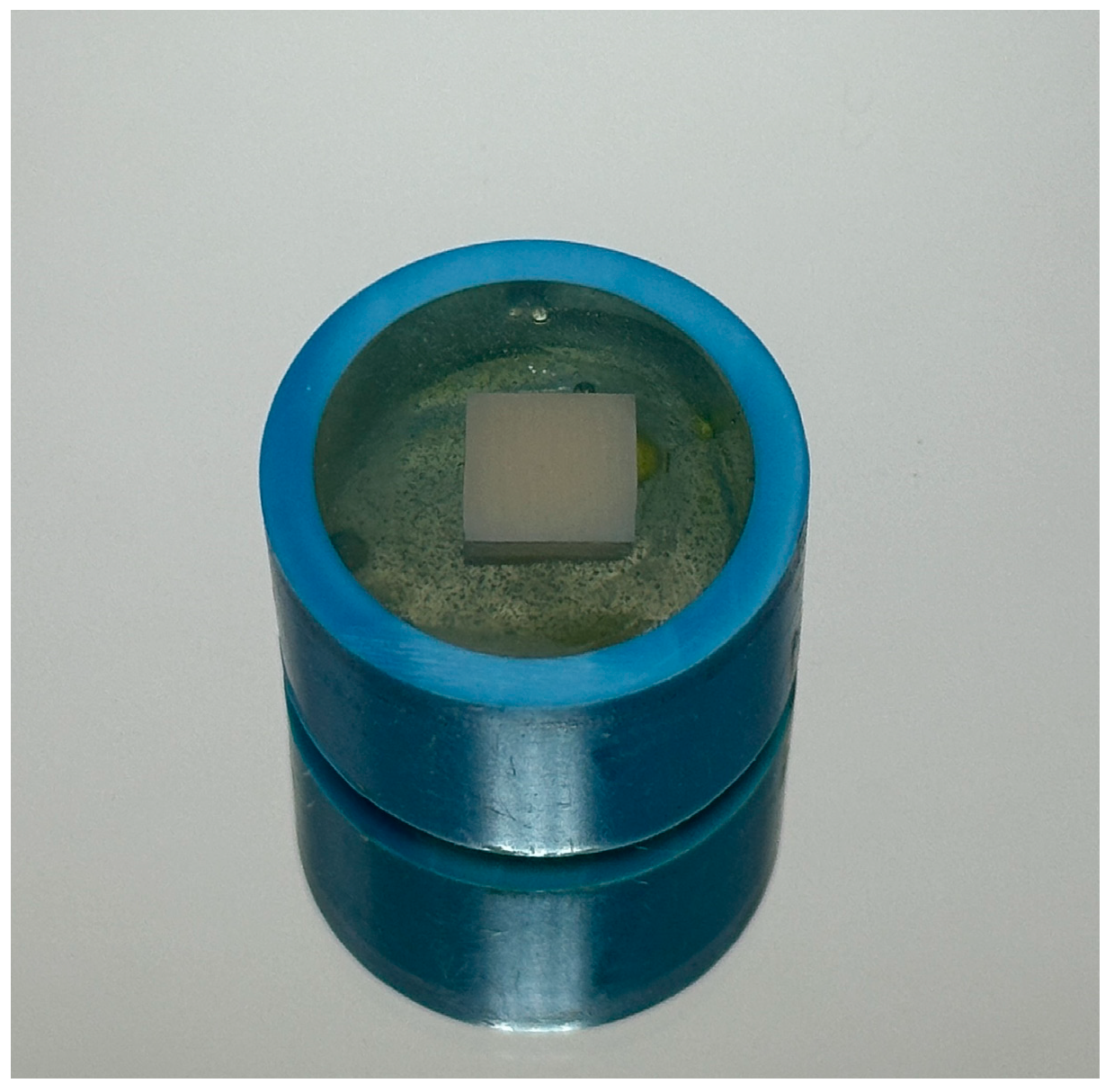
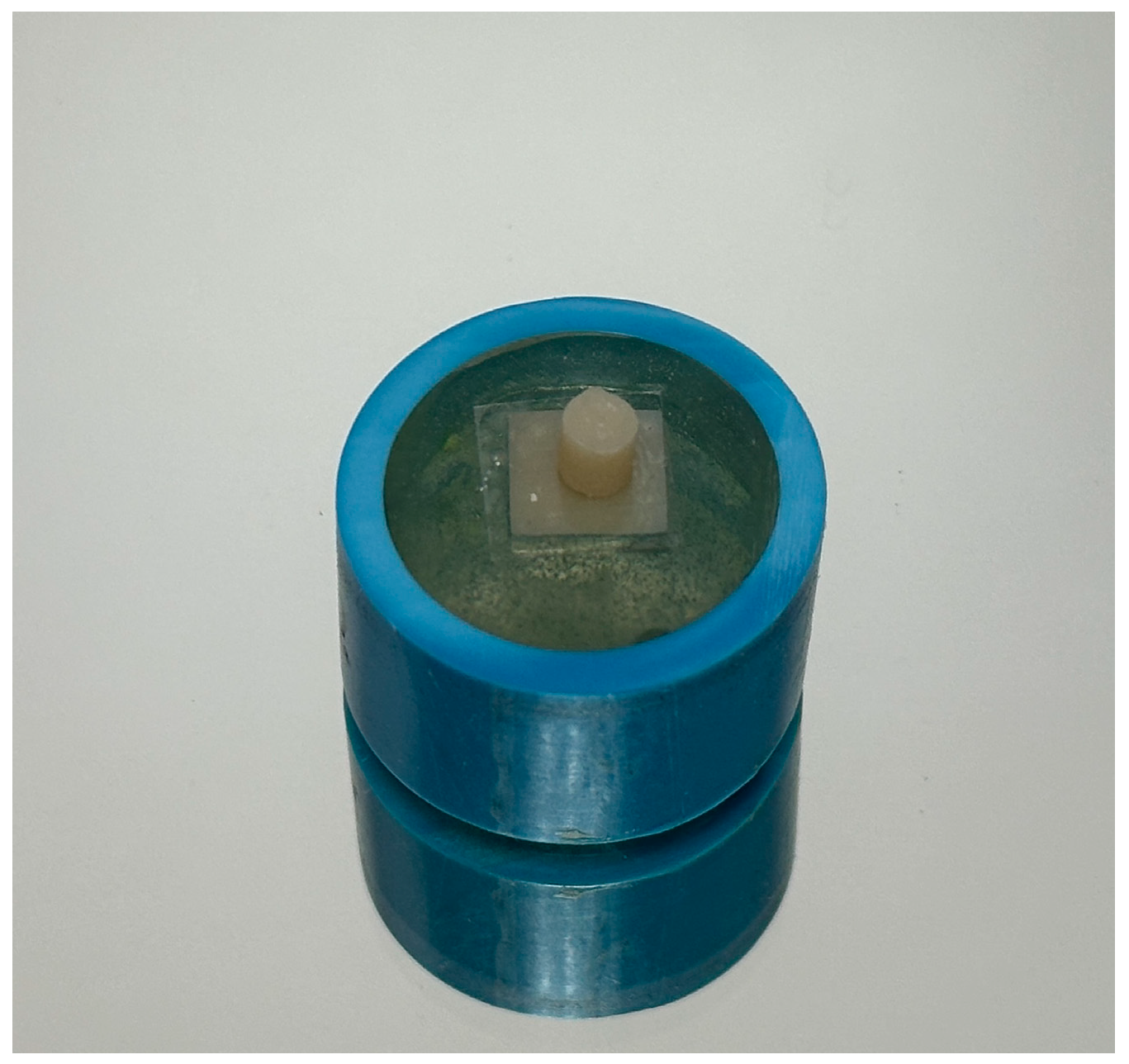
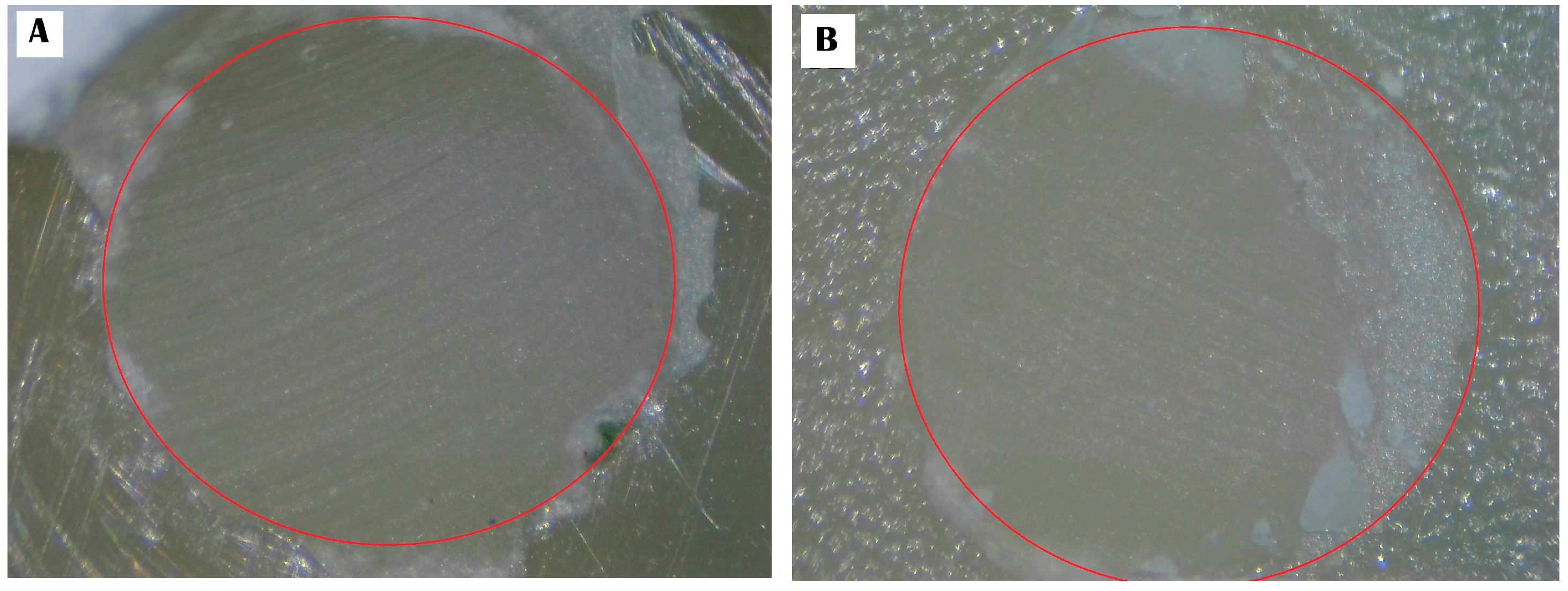
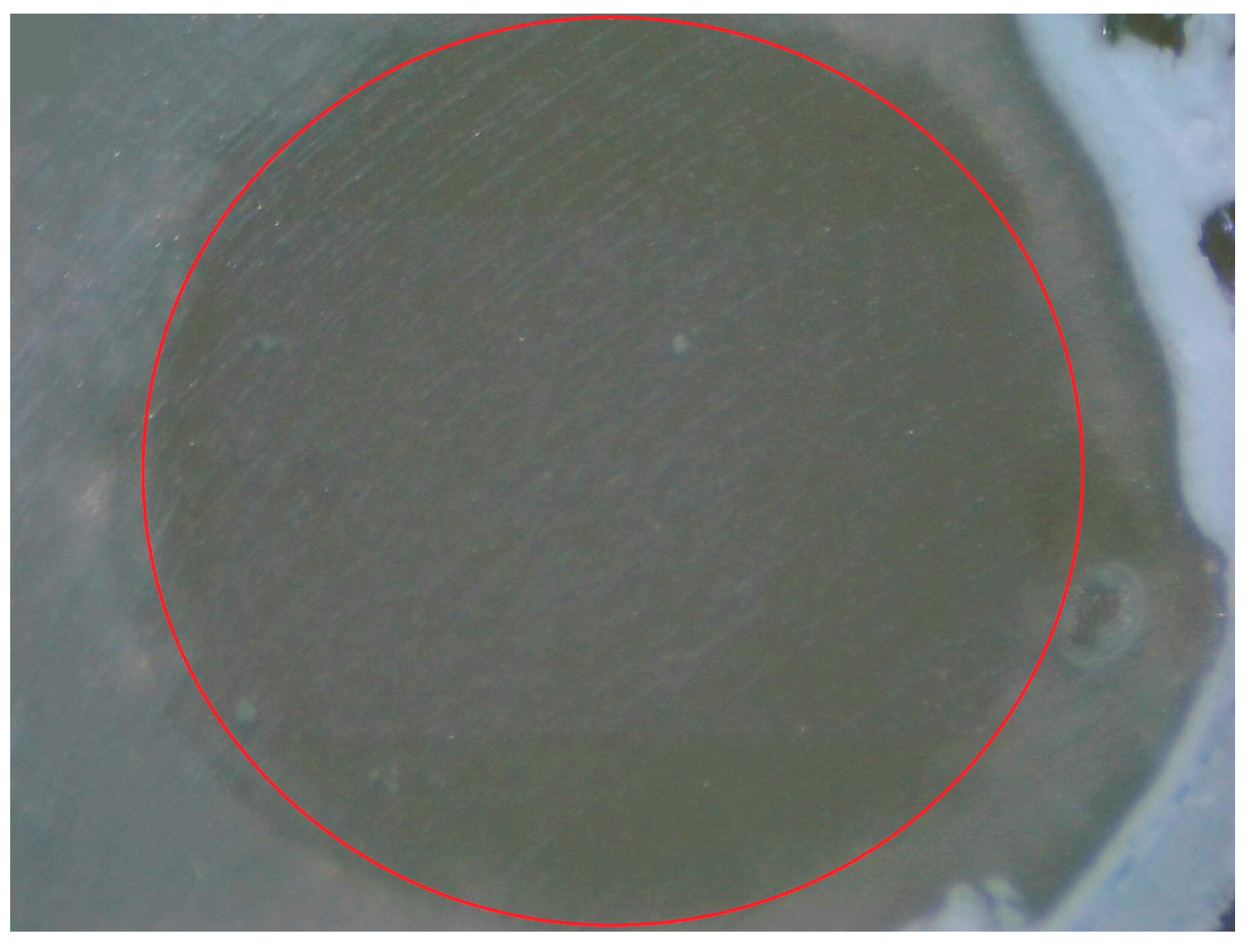
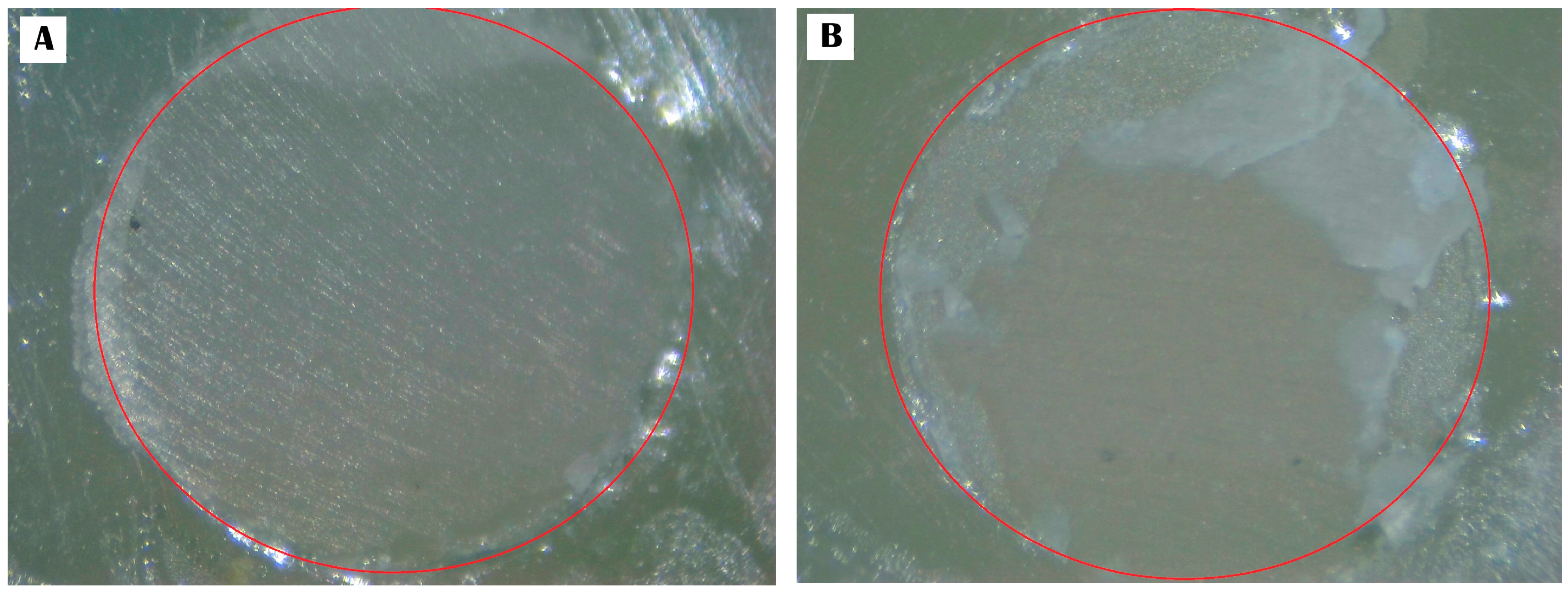

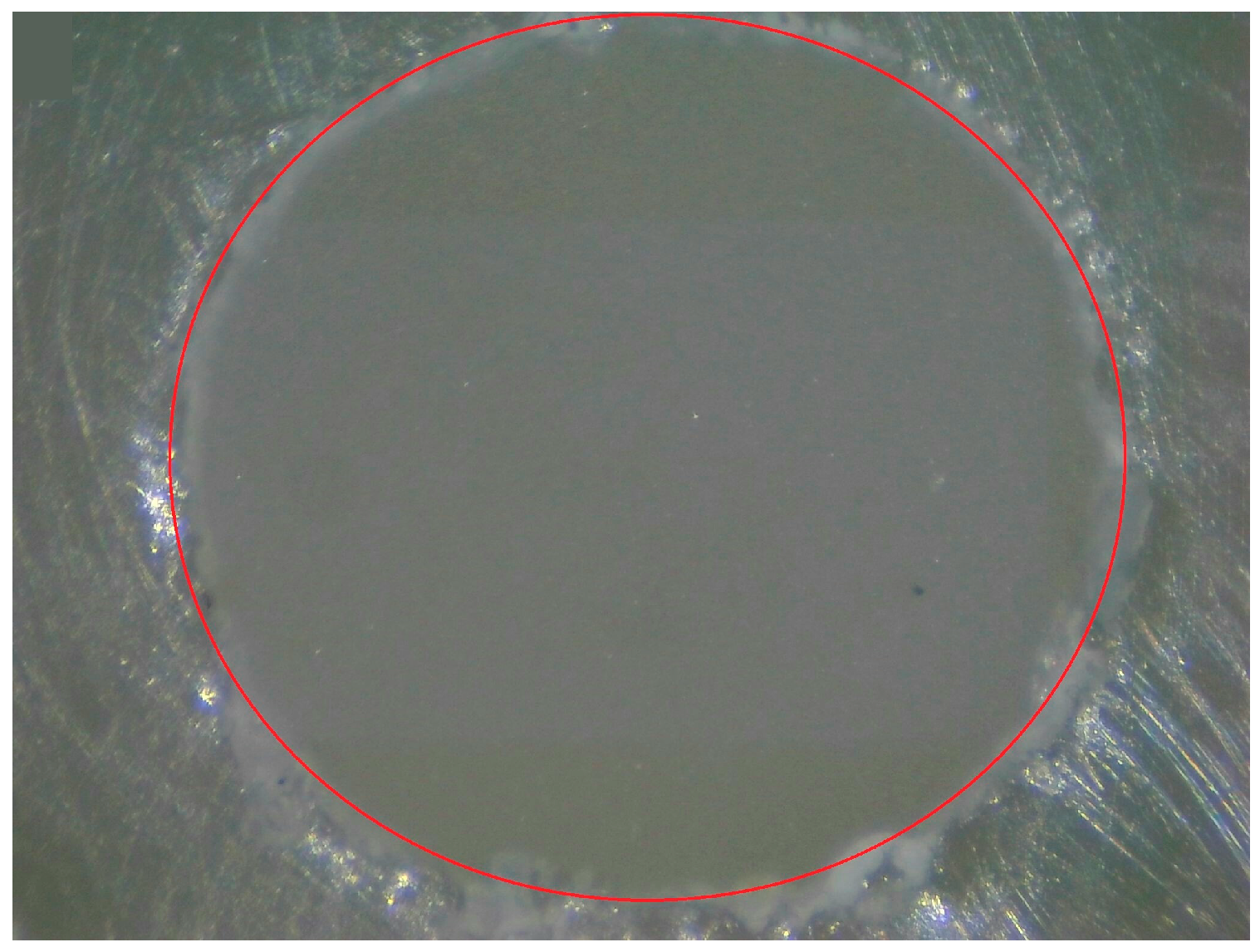
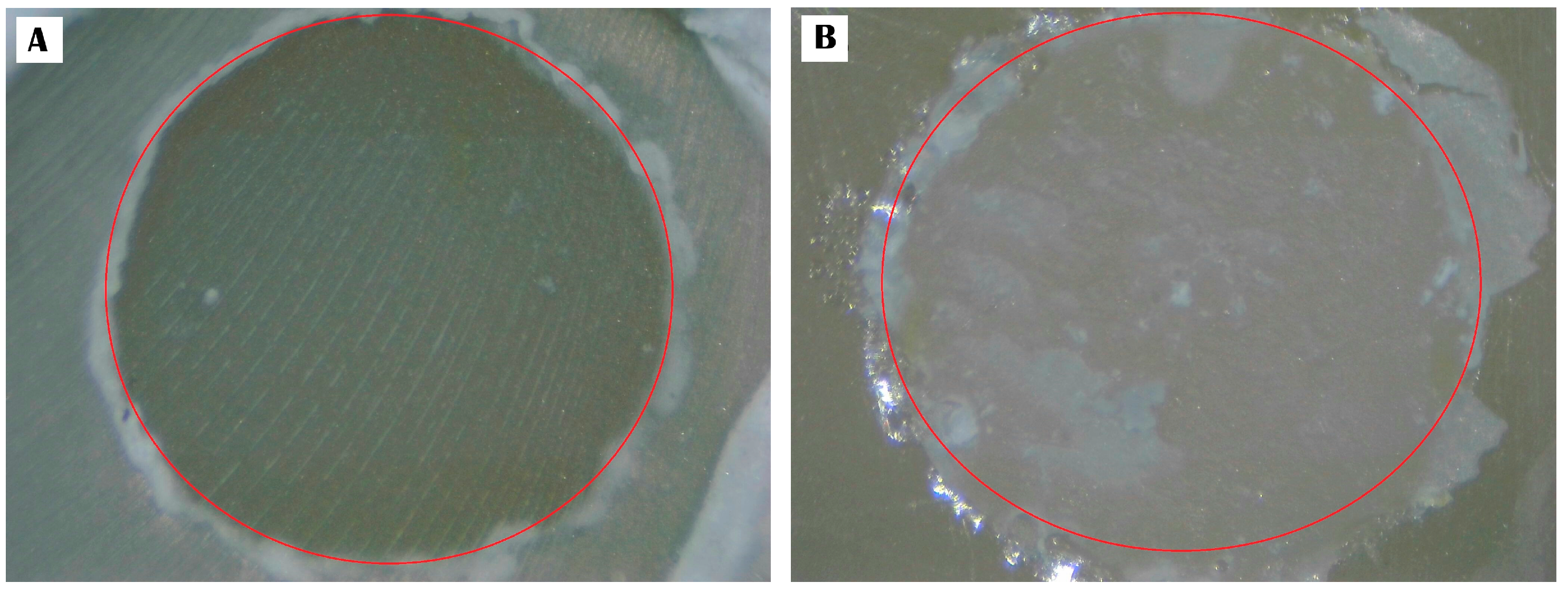
| Material | Composition |
|---|---|
| Clearfil DC activator (Kuraray Noritake Dental Inc., Okayama, Japan) | Sodium sulfonate salt and ethanol. |
| RelyX universal resin cement (3M, Seefeld, Germany) | Surface-treated glass powder filler, phosphate ester monomer, TEGDMA, diurethane dimethacrylate, silica filler, initiator, titanium dioxide. |
| Maxcem elite chroma (Kerr corporation, Orange, CA, USA) | Methacrylate ester monomers, GPDM, proprietary self-curing redox activator, camphorquinone, fluoraluminosilicate glass filler, silica, barium glass filler, activators, stabilizers. |
| Panavia SA cement multi (Kuraray Noritake Dental Inc., Okayama, Japan) | Paste A: 10-MDP, Bis-GMA, TEGDMA, HEMA, silanated barium glass filler, silanated colloidal silica, dl-camphorquinone, peroxide, catalysts, pigments. Paste B: hydrophobic aromatic dimethacrylate, silane coupling agent, silanated barium glass filler, aluminum oxide filler, surface-treated sodium fluoride (less than 1%), dl-camphorquinone, accelerators, pigments, filler content: 40 vol%, 62 wt.%. |
| Resin composite, Harmonize A4E (Kerr corporation, Orange, CA, USA) | Bis-GMA, TEGDMA, EBPADMA, zirconia/silica cluster filler comprising 20 nm spherical fumed silica and 5 nm zirconia particles, pre-polymerized filler. |
| Group | Surface Alteration |
|---|---|
| 1 | untreated with DCA and bonded with RXS (RXS) |
| 2 | untreated with DCA and bonded with MAC (MAC) |
| 3 | untreated with DCA and bonded with PSM (PSM) |
| 4 | treated with DCA and bonded with RXS (DCA + RXS) |
| 5 | treated with DCA and bonded with MAC (DCA + MAC) |
| 6 | treated with DCA and bonded with PSM (DCA + PSM) |
| Group | Mean SBS ± SD | Failure Type | ||
|---|---|---|---|---|
| Adhesive | Mixed | Cohesive | ||
| 1. RXS | 11.17 ± 0.86 A | 80 | 20 | 0 |
| 2. MAC | 4.93 ± 0.53 B | 100 | 0 | 0 |
| 3. PSM | 11.48 ± 1.17 A | 80 | 20 | 0 |
| 4. DCA + RXS | 15.45 ± 1.20 C | 80 | 20 | 0 |
| 5. DCA + MAC | 9.94 ± 0.67 D | 100 | 0 | 0 |
| 6. DCA + PSM | 15.61 ± 0.68 C | 70 | 30 | 0 |
Disclaimer/Publisher’s Note: The statements, opinions and data contained in all publications are solely those of the individual author(s) and contributor(s) and not of MDPI and/or the editor(s). MDPI and/or the editor(s) disclaim responsibility for any injury to people or property resulting from any ideas, methods, instructions or products referred to in the content. |
© 2024 by the authors. Licensee MDPI, Basel, Switzerland. This article is an open access article distributed under the terms and conditions of the Creative Commons Attribution (CC BY) license (https://creativecommons.org/licenses/by/4.0/).
Share and Cite
Akrawatcharawittaya, P.; Sriamporn, T.; Vuddhakanok, S.; Thamrongananskul, N.; Klaisiri, A. The Effect of a Dual Cure Activator on Self-Adhesive Resin Cements and Zirconia Shear Bond Strength. Ceramics 2024, 7, 1237-1246. https://doi.org/10.3390/ceramics7030082
Akrawatcharawittaya P, Sriamporn T, Vuddhakanok S, Thamrongananskul N, Klaisiri A. The Effect of a Dual Cure Activator on Self-Adhesive Resin Cements and Zirconia Shear Bond Strength. Ceramics. 2024; 7(3):1237-1246. https://doi.org/10.3390/ceramics7030082
Chicago/Turabian StyleAkrawatcharawittaya, Phalat, Tool Sriamporn, Suchada Vuddhakanok, Niyom Thamrongananskul, and Awiruth Klaisiri. 2024. "The Effect of a Dual Cure Activator on Self-Adhesive Resin Cements and Zirconia Shear Bond Strength" Ceramics 7, no. 3: 1237-1246. https://doi.org/10.3390/ceramics7030082







